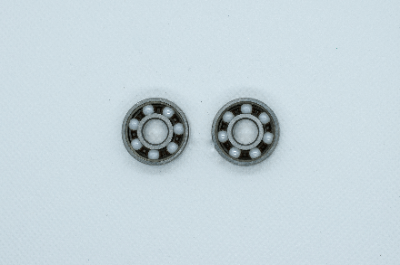What Is a Ceramic Bearing?
 A Ceramic Bearing is a bearing that uses ceramic as its material. Ceramic bearings are lighter than metal bearings because they are made of ceramic.
A Ceramic Bearing is a bearing that uses ceramic as its material. Ceramic bearings are lighter than metal bearings because they are made of ceramic.
Ceramic bearings are also more resistant to corrosion and wear than metal bearings. Ceramic bearings are therefore used in corrosive environments and electromagnetic atmospheres.
Uses of Ceramic Bearings
Ceramic Bearings are widely used in consumer products. Typical examples are refrigerators, washing machines, and vacuum cleaners. Ceramic Bearings may be used in equipment that is in close proximity to food or the human body for hygienic reasons.
In industrial applications, ceramic bearings are used in clean rooms, vacuum environments, high-temperature environments, and underwater. Due to their high resistance to high temperatures and wear, they are suitable for equipment in the above environments.
Examples of industrial applications are as follows:
- Food and chemical manufacturing equipment
- Bearings in generators and turbines
- Liquid fuel transfer pumps
- Semiconductor manufacturing equipment and space industry equipment
- Inspection equipment and machine tools
Principle of Ceramic Bearings
Ceramics are inorganic compounds synthesized by combining metallic and non-metallic elements. The combination of metal and non-metal elements make it lightweight and resistant to corrosion and high temperatures. It also has high hardness and wear resistance.
Ceramic Bearings can be used in harsh environments because the material is ceramic. Because the characteristics vary depending on the type and ratio of the elements combined, a variety of Ceramic Bearings are available for different purposes of use.
Other special material bearings include resin bearings, stainless steel bearings, and urethane bearings. Each is used according to the application.
Other Information on Ceramic Bearings
1. Ceramic Bearing Life
Ceramic Bearings are generally made of silicon nitride, which has a higher rigidity than high-carbon chromium bearing steel, the material used in metal bearings. This results in higher contact stress, and the difference in rigidity due to material does not simply translate into a difference in life.
Although the load rating of Ceramic Bearings is specified to be equivalent to that of metal bearings, life tests have confirmed that the life of Ceramic Bearing is equal to or greater than that of metal bearings. Therefore, the life tends to be longer than the calculated value.
Flaking due to fatigue occurs in bearings that have reached their life expectancy, just as it does in metal bearings.
In addition, silicon nitride has about half the mass of high-carbon chromium bearing steel. As a result, centrifugal force during rotation is small, heat generation is small, and thermal deformation is virtually nonexistent. When rotating at high speeds under high temperatures, it exhibits superior characteristics to metal bearings.
2. Accuracy of Ceramic Bearing
The accuracy of Ceramic Bearing is also determined by the accuracy grade of the bearing. Technically, it is possible to produce ISO Grade 3 or higher, but it is more expensive; ISO-Grade 3 is ultra-high precision with a diameter of 12.7 mm or less, diameter variation, and sphericity of 0.08 μm or less. Therefore, they are used for special applications such as ultra-high-speed, high-precision spindles with rotational speeds of 100,000 RPM or higher.
In addition, Ceramic Bearings maintain their accuracy even under high temperatures because of less thermal expansion and thermal deformation compared to metal bearings. Therefore, they are suitable for use in high-temperature environments.
Although the rotational accuracy of a bearing requires the accuracy of the bearing itself, the housing and rotating shaft have a considerably greater effect. In addition to using high-precision bearings, the parts surrounding the bearing must also be machined to high precision. Since the accuracy also depends on the assembly, skilled assembly techniques are required for high-precision rotary components.